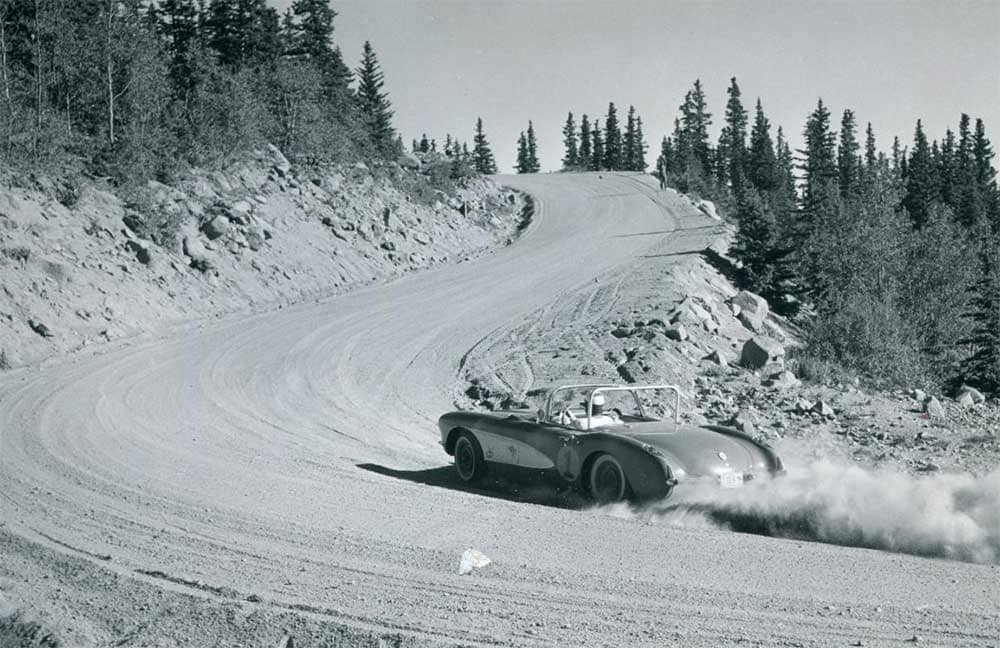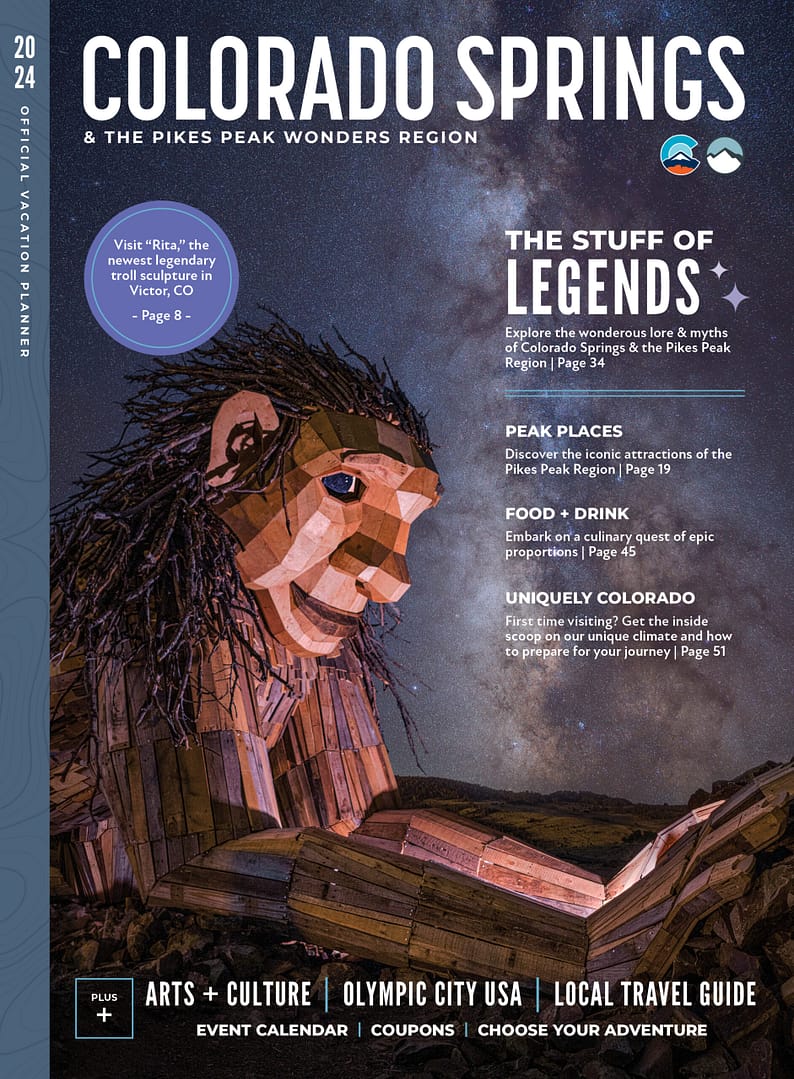The 2025 Pikes Peak International Hill Climb: History, Cool Facts and Spectator Guide
The intensity is high as racers from all over the world converge on America’s Mountain to compete in one of the most epic races around — the Pikes Peak International Hill Climb on the world-famous Pikes Peak Highway. This year marks the 103rd running of the Pikes Peak Hill Climb, also known as the Race to the Clouds. You don’t have to be a race fanatic to get excited about this adventure.
Even a novice fan can appreciate a race that ascends for 12.42 miles (20 km) to summit Colorado Springs’ famous fourteener. That’s a climb of more than 4,700 feet (1,432 meters)! Drivers must maneuver through 156 turns, some alongside steep cliffs with no guardrails, all while hitting speeds upwards of 140 miles per hour (225 kph). We’ll share these stats and a few more fun facts below. First, however, let’s take a look back at the early days of the hill climb — the same rebellious tenacity, but a lot more gravel.
PPIHC-2024 Race Highlights-Final
The Early History of the Pikes Peak International Hill Climb
If you’ve had the incredible opportunity to catch a race or even just drive up the Pikes Peak Highway at the much more reasonable speed of 25 miles per hour (40 kph), you can give a silent nod of thanks to the man who made it happen — Spencer Penrose.
Spencer Penrose was an important person in the development of Colorado Springs and the Pikes Peak region. While he wasn’t the orderly taskmaster that William J. Palmer was (a notorious teetotaler and the city’s founder), he was no less a key player in creating several famous attractions in the Pikes Peak region. The Cheyenne Mountain Zoo is one of the most popular of his contributions. He also built the Broadmoor (to thwart Palmer and the United States’ liquor bans) and, important to our story here, the Pikes Peak Highway.
Before Penrose, tourists and visitors journeyed up Pikes Peak on foot, via the railroad and on the backs of donkeys. There was also a simple carriage road that took visitors precariously up to the summit in wagons. In the early 1900s, Penrose and a group of investors saw potential in that narrow, rickety dirt track, and began to invest in converting it to a real road. Penrose and his investors finally completed the conversion in 1915. To promote it, Penrose had an incredibly unique (and fairly shocking) idea: Let’s host a race to the summit! It was the kind of idea that would make most people balk. Penrose was never one to balk when he could run headfirst instead. Thus, a new race was born.
1916: The First Race to the Clouds
The first race was run in 1916. Back then, the race was known as the Pikes Peak Auto Hill Climb. The El Pomar Foundation noted that 650 news outlets were present at the first race, a pretty spectacular turnout for Penrose’s inaugural event. The Foundation also shares that Penrose commissioned a stunning silver trophy with silversmith’s Bailey, Banks and Biddle. The trophy was huge, ornate and completely appropriate recognition for the accomplishment. You can visit the Penrose Museum’s Pikes Peak Hill Climb exhibit for more of these cool race facts — it’s free!
The Pikes Peak Hill Climb — Before Pavement
Back in 1916, the roads were gravel, the cars were experimental and the airbags were nonexistent. The vehicles did not have too many names you’ll find on the road today. Cadillac is one notable make. Other vehicles may be familiar to car enthusiasts: Stutz, Delage, Hudson, Duesenberg and more. It was difficult to race early vehicles. The Hill Climb website reports that mechanics used to have to ride along with the drivers to make repairs on the ride, considering how unpredictable automobiles were in the early years. Even modern vehicles struggle at the higher altitude. Combustion engines are not good with the lack of oxygen.
The smallest car in the race, the Romano Demon Special, would best them all. Driven by a 22-year-old young man named Rea Lentz, the Demon would reach the summit in 20 minutes and 55 seconds. To put that in perspective, in 101 years, racers have only managed to subtract about 12 minutes off that founding finish time driving advanced vehicles that Penrose and the drivers back then could never have imagined.
Per PPIHC lore, Mr. Lentz was never seen again. While that sounds a little ominous, we think the $10,000 cash value of the trophy had a lot to do with Lentz’s decision to move on with his life. We did the math (well, Google did the math) and that’s about $269,000 USD in today’s dollars.
1920 — The Hill Climb Continues
Despite the buzz and excitement surrounding the first race, the United States would enter World War I in 1917. As such, the race was halted until 1920. In 1920, it began again, sanctioned by the American Automobile Association (AAA) and ready to run in the Rockies once more. For the decades that followed, the track itself would remain nearly unchanged. The cars, however, evolved to become drastically different from the early roofless and structurally unreliable predecessors. Motorcycles and new vehicle classes also entered the competition. If you thought it was terrifying to watch someone race up on four wheels, close your eyes when the two-wheelers hit the pavement.
Speaking of pavement, the PPIHC was once a gravel track as you reached the summit. That’s a pretty scary concept when you see the switchbacks and curves that make up the Pikes Peak Highway. Somehow, drivers managed to stick it out. After 2011, racers no longer had to navigate gravel. The highway completed paving to the summit as part of an agreement to mitigate the damage caused by tons of loose gravel spilling into the forest and waterways below the summit. Many drivers were disappointed in the reduction in challenge and had to learn to love a race 10% less likely to launch you into a ravine.
Fast Facts About the Race to the Clouds
14,115 feet: The elevation of the Pikes Peak summit
103: Number of years the race has successfully run
20:55.600: The winning time of the first PPIHC, achieved by Rea Lentz
7:57.148: The new course record set in 2018
12.42: The number of miles to the summit (20 kilometers)
4,725: The number of feet ascended during the race (1,432 meters)
The 2025 Pikes Peak International Hill Climb Spectator Guide
Now that you know the history, let’s focus on the present and your presence at the 2025 Pikes Peak International Hill Climb.
Pikes Peak International Hill Climb Tickets and Camping
Race day tickets and all track-adjacent camp sites sell out extremely fast. If you are reading this and do not have tickets yet, buy them sooner than later. The closer you get to race day, the more likely it is that your favorite spot will be gone. Do not despair if you miss out on the main tickets. You can still catch practice day tickets here. No tickets of any type will be sold at the gate. Purchase your tickets online ahead of time.
Practice Day Ticket Info:
Practice days are June 17, 18, 19 and 20.
Time: Attendees must arrive between 4-4:45 a.m. No exceptions will be made for late arrivals. Per the Spectator Guide: “The Start Line (7 miles past gateway) closes to uphill traffic at 4:45 am. If viewing from Devils Playground, arrive at the Gateway at 4:00 am.”
Cost: $85-$115 per person, per day
1 ticket = 1 day
Viewing sites: Devil’s Playground, Glen Clove (limited) and the Starting Line
Admission does not include access to the Pikes Peak Highway or Summit House. You will be required to leave and re-enter.
Where to Stay
415 S Nevada Ave, Colorado Springs, CO 80903
(719) 203-9309
481 Manitou Ave, Manitou Springs, CO 80829
(719) 685-5492
2850 S Circle Dr, Colorado Springs, CO 80906
(719) 430-5400
2 El Paso Blvd, Colorado Springs, CO 80904
(719) 634-2851
710 Rock Creek Canyon Rd Suite 200, Colorado Springs, CO 80926
(719) 576-0450
Where to Watch or Listen
If you haven’t gotten tickets to the race, you can still follow along from the following sources:
Race Day Details
Parking
Important: If you park anywhere above the starting line, you will not be able to leave until the race ends. That can be well after 4 p.m.
You must park in the designated parking area associated with your ticket. The parking attendants will check your ticket! The positive side to this is that you are guaranteed a parking spot in your designated parking area. No need to stress about getting a parking spot. However, that does not mean you should arrive late. You want to be past the starting line before 5:30 a.m.
The gates open at 2 a.m. for Devil’s Playground with a rolling open time for the other viewing locations (see below). Per PPIHC: “Spectators/vehicles are not allowed in line before 2:00 a.m. on Sunday. Plan accordingly, no vehicles will be allowed past the Start Line after 5:30 a.m.”
- Devils Playground – 2:00am
- Glen Cove – 3:00am
- Cove Creek – 3:00am
- Ski Area – No Race Day Parking
- Halfway Picnic Grounds – 3:30am
- 9 Mile – No Race Day Parking
- Pits / Turn 1 Viewing – 4:30am
Please note there are also limited “fan bus” tickets available for those who do not want to drive. These are more expensive and you will want to act fast to secure a fan bus ticket — they will sell out. Check Glen Cove and Devil’s Playground when purchasing tickets.
Viewing Areas
- Devil’s Playground
- Cove Creek
- Glen Cove
- Ski Area
- Halfway Picnic Grounds
- Starting Line
Safety
Follow all signage and warnings, as well as directions from the event staff. The Hill Climb is a dangerous spectator sport. Attendees are at risk of being hit by vehicles, loose gravel or other projectiles. PPIHC have designed spectator areas to keep spectators as safe as possible. Spectators will be issued trespassing tickets for leaving designated areas.
- Do not move up and down the course after the race begins.
- Do not sit on or approach hay bales. They are arranged to slow out-of-control vehicles. You are not.
- Do not build lean-tos or tree stands.
- No pets.
- Keep a barrier between your body and the course. Trees, rocks, other cars — anything that can stop a stray tire or fender from hitting you on the sidelines.
The Race to the Clouds is a historic, adrenaline-packed tradition that showcases the wild spirit at the core of the Pikes Peak region. Whether you have tickets to the sidelines or plan to cheer from the barstool or your living room couch, you’re sure to feel the rush that has driven racers for over a century.










